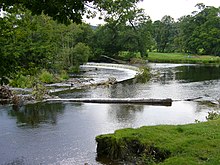Horseshoe Falls (Wales)
| Horseshoe Falls | |
|---|---|

Horseshoe Falls
|
|
| Location | About 3 miles (4.8 km) west of Llangollen |
| OS grid | SJ195433 |
| Coordinates | 52°58′52″N 3°11′57″W / 52.98111°N 3.19917°WCoordinates: 52°58′52″N 3°11′57″W / 52.98111°N 3.19917°W |
| Type | artificial |
| Elevation | 330 ft (100 m) |
| Watercourse | River Dee |
| Average flow rate |
13.7 M gals per day (62 Mld) |
Horseshoe Falls (Welsh: Rhaeadr y Bedol) (grid reference SJ196433) is a weir on the River Dee near Llantysilio Hall in Denbighshire, Wales, about 5 kilometres (3 mi) north-west of the town of Llangollen.
The distinctively shaped weir, which is 460 feet (140 m) long, helps create a pool of water that can enter the Llangollen Canal (via an adjacent valve house and flow meter). The canal west of Pontcysyllte Aqueduct and the construction of the weir were authorised by an Act of Parliament obtained in 1804 by the Ellesmere Canal Company. The canal was a navigable feeder, which supplied water to the Ellesmere Canal beyond Pontcysyllte, and to the Chester Canal, to which it connected near Nantwich. Thomas Telford was the civil engineer responsible for the design, and the canal and feeder were completed in 1808.
The weir was an important factor in the retention of the canal to Llangollen when the owners of the entire Shropshire Union system, the London, Midland and Scottish Railway, decided to close much of the network in 1944. They retained the line of the former Chester Canal and the Ellesmere Canal from Nantwich to Ellesmere Port, the branch of the Chester Canal to Middlewich and the former Birmingham and Liverpool Junction Canal main line from Nantwich to Wolverhampton. Because Horseshoe Falls was a major source of water to that system, the canal from Llangollen to Nantwich, including the great aqueducts at Pontcysyllte and Chirk, was retained purely as a water supply channel. This action enabled the canal to survive until it was taken over by British Waterways following nationalisation in 1948. With the steady decline in commercial traffic, British Waterways negotiated with the Mid and South East Cheshire Water Board, and the canal is used to transfer water from the Dee at Llantysilio to a reservoir near Hurleston Junction, to the north of Nantwich. In 2009, some 13.7 million imperial gallons (62 Ml) per day was conveyed along the canal. Under British Waterways, the canal has become one of the most popular cruising canals in the country. The final 1.7 miles (2.7 km) from Llangollen to the Falls is not navigable by motorised boats, as it is not wide enough for vessels to turn round, but the towpath extends along the bank right up to the Falls.
...
Wikipedia

